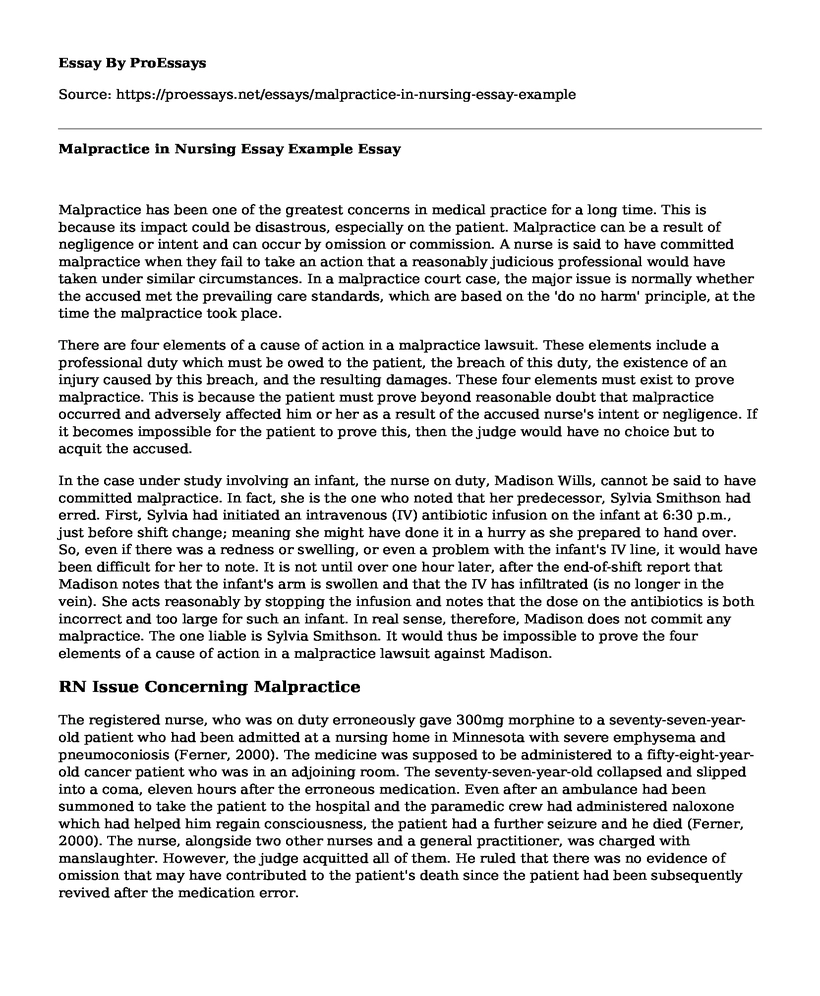Malpractice has been one of the greatest concerns in medical practice for a long time. This is because its impact could be disastrous, especially on the patient. Malpractice can be a result of negligence or intent and can occur by omission or commission. A nurse is said to have committed malpractice when they fail to take an action that a reasonably judicious professional would have taken under similar circumstances. In a malpractice court case, the major issue is normally whether the accused met the prevailing care standards, which are based on the 'do no harm' principle, at the time the malpractice took place.
There are four elements of a cause of action in a malpractice lawsuit. These elements include a professional duty which must be owed to the patient, the breach of this duty, the existence of an injury caused by this breach, and the resulting damages. These four elements must exist to prove malpractice. This is because the patient must prove beyond reasonable doubt that malpractice occurred and adversely affected him or her as a result of the accused nurse's intent or negligence. If it becomes impossible for the patient to prove this, then the judge would have no choice but to acquit the accused.
In the case under study involving an infant, the nurse on duty, Madison Wills, cannot be said to have committed malpractice. In fact, she is the one who noted that her predecessor, Sylvia Smithson had erred. First, Sylvia had initiated an intravenous (IV) antibiotic infusion on the infant at 6:30 p.m., just before shift change; meaning she might have done it in a hurry as she prepared to hand over. So, even if there was a redness or swelling, or even a problem with the infant's IV line, it would have been difficult for her to note. It is not until over one hour later, after the end-of-shift report that Madison notes that the infant's arm is swollen and that the IV has infiltrated (is no longer in the vein). She acts reasonably by stopping the infusion and notes that the dose on the antibiotics is both incorrect and too large for such an infant. In real sense, therefore, Madison does not commit any malpractice. The one liable is Sylvia Smithson. It would thus be impossible to prove the four elements of a cause of action in a malpractice lawsuit against Madison.
RN Issue Concerning Malpractice
The registered nurse, who was on duty erroneously gave 300mg morphine to a seventy-seven-year-old patient who had been admitted at a nursing home in Minnesota with severe emphysema and pneumoconiosis (Ferner, 2000). The medicine was supposed to be administered to a fifty-eight-year-old cancer patient who was in an adjoining room. The seventy-seven-year-old collapsed and slipped into a coma, eleven hours after the erroneous medication. Even after an ambulance had been summoned to take the patient to the hospital and the paramedic crew had administered naloxone which had helped him regain consciousness, the patient had a further seizure and he died (Ferner, 2000). The nurse, alongside two other nurses and a general practitioner, was charged with manslaughter. However, the judge acquitted all of them. He ruled that there was no evidence of omission that may have contributed to the patient's death since the patient had been subsequently revived after the medication error.
Reference
Ferner, R. E. (2000). Medication errors that have led to manslaughter charges. BMJ, 321(7270), 1212-1216.
Cite this page
Malpractice in Nursing Essay Example. (2022, Dec 14). Retrieved from https://proessays.net/essays/malpractice-in-nursing-essay-example
If you are the original author of this essay and no longer wish to have it published on the ProEssays website, please click below to request its removal:
- Essay Sample on Cox Simulation Experience and Reflection
- Should Nurses Donate Their Services? - Argumentative Essay
- Nicotine Replacement Therapy Research Paper Example
- Smartphone and Social Media Use in Healthcare Paper Example
- E-Cigarettes Smoking - Essay Sample
- Essay on Reaping Benefits of Disabled Worker Diversity: Tangible Benefits of Hiring Disabled Employees
- Health Care System Needs Improvement for Patient Safety - Essay Sample







